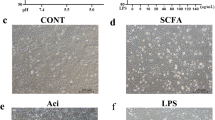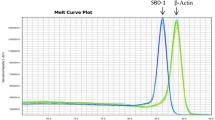Abstract
Subacute ruminal acidosis (SARA) is a common nutritional metabolic disease in ruminants that causes significant economic losses to dairy farming. Strontium (Sr) is known to be involved in bone metabolism and exhibits potent anti-inflammatory effects. To evaluate the effect of Sr on inflammation in bovine ruminal epithelial cells, a model of LPS-induced inflammation was established in this study, and the cell viability of bovine ruminal epithelial cells was measured using CCK-8. The production of pro-inflammatory cytokines was measured by ELISA and real-time PCR, respectively. The related proteins of the TLR4/MyD88/NF-κB pathway were assayed through Western blotting, and the fluorescence of p-p65 and p-IκB were assayed by immunofluorescence. Molecular docking of Sr and TLR4/MyD88/NF-κB pathway-related proteins was performed using MIB2 (http://bioinfo.cmu.edu.tw/MIB2/). Results showed that after treatment for 24 h, the cell viability was decreased at the high concentration of Sr (≥ 10 mmol/L). Sr significantly decreased the production of TNF-α, IL-1β, and IL-6, downregulated the related proteins expression of the TLR4/MyD88/NF-κB pathway, and reduced the fluorescence levels of p-p65 and p-IκB. The NF-κB pathway inhibitor PDTC and molecular docking further revealed that Sr reduced LPS-induced pro-inflammatory cytokines production via the TLR4/MyD88/NF-κB pathway. These results suggest that Sr reduces LPS-induced pro-inflammatory cytokines production via the TLR4/MyD88/NF-κB pathway, thereby exerting an anti-inflammatory effect in bovine ruminal epithelial cells, providing a basis for Sr in the treatment of bovine rumen acidosis disease.








Similar content being viewed by others
References
Hu XY, Li S, Mu RY, Guo J, Zhao CJ, Cao YG, Zhang NS, Fu YH (2022) The rumen microbiota contributes to the development of mastitis in dairy cows. Microbiol Spectr 10:e0251221. https://doi.org/10.1128/spectrum.02512-21
Fu YH, He YH, **ang KH, Zhao CJ, He ZQ, Qiu M, Hu XY, Zhang NS (2022) The role of rumen microbiota and its metabolites in subacute ruminal acidosis (SARA)-induced inflammatory diseases of ruminants. Microorganisms 10:1495. https://doi.org/10.3390/microorganisms10081495
Abdela N (2016) Sub-acute ruminal acidosis (SARA) and its consequence in dairy cattle: a review of past and recent research at global prospective. Achiev Life Sci 10:187–196. https://doi.org/10.1016/j.als.2016.11.006
Elmhadi ME, Ali DK, Khogali MK, Wang H (2022) Subacute ruminal acidosis in dairy herds: microbiological and nutritional causes, consequences, and prevention strategies. Anim Nutr 10:148–155. https://doi.org/10.1016/j.aninu.2021.12.008
Zeng JL, Lv JS, Duan HW, Yang S, Wu JX, Yan ZX, Zhang R, Hu JJ, Zhang Y (2023) Subacute ruminal acidosis as a potential factor that induces endometrium injury in sheep. Int J Mol Sci 24:1192. https://doi.org/10.3390/ijms24021192
Chang GJ, Wang LL, Ma NN, Zhang WW, Zhang HM, Dai HY, Shen XZ (2018) Histamine activates inflammatory response and depresses casein synthesis in mammary gland of dairy cows during SARA. BMC Vet Res 14:168. https://doi.org/10.1186/s12917-018-1491-3
Sun X, Yuan X, Chen L, Wang T, Wang Z, Sun G, Li X, Li X, Liu G (2017) Histamine induces bovine ruminal epithelial cell inflammatory response via NF-kappaB pathway. Cell Physiol Biochem 42:1109–1119. https://doi.org/10.1159/000478765
Zhao CX, Liu GW, Li XB, Guan Y, Wang YZ, Yuan X, Sun GQ, Wang Z, Li XW (2018) Inflammatory mechanism of rumenitis in dairy cows with subacute ruminal acidosis. BMC Vet Res 14:135. https://doi.org/10.1186/s12917-018-1463-7
Rodriguez J, Escudero ND, Mandalunis PM (2012) Effect of strontium ranelate on bone remodeling. Acta Odontol Latinoam 25:208–213
Wirsig K, Kilian D, von Witzleben M, Gelinsky M, Bernhardt A (2022) Impact of Sr(2+) and hypoxia on 3D triple cultures of primary human osteoblasts, osteocytes and osteoclasts. Eur J Cell Biol 101:151256. https://doi.org/10.1016/j.ejcb.2022.151256
Bonnelye E, Chabadel A, Saltel F, Jurdic P (2008) Dual effect of strontium ranelate: stimulation of osteoblast differentiation and inhibition of osteoclast formation and resorption in vitro. Bone 42:129–138. https://doi.org/10.1016/j.bone.2007.08.043
Silva GAB, Bertassoli BM, Sousa CA, Albergaria JD, de Paula RS, Jorge EC (2018) Effects of strontium ranelate treatment on osteoblasts cultivated onto scaffolds of trabeculae bovine bone. J Bone Miner Metab 36:73–86. https://doi.org/10.1007/s00774-017-0822-y
Liu Z, Mo X, Ma F, Li S, Wu G, Tang B, Lin L (2021) Synthesis of carboxymethyl chitosan-strontium complex and its therapeutic effects on relieving osteoarthritis. Carbohydr Polym 261:117869. https://doi.org/10.1016/j.carbpol.2021.117869
Römer P, Desaga B, Proff P, Faltermeier A, Reicheneder C (2012) Strontium promotes cell proliferation and suppresses IL-6 expression in human PDL cells. Ann Anat-Anatomischer Anzeiger 194:208–211. https://doi.org/10.1016/j.aanat.2011.09.008
Peng Y, Ma FB, Hu LQ, Deng YQ, He WQ, Tang B (2022) Strontium based polysaccharides promote osteoblasts differentiation and mineralization. Int J Biol Macromol 205:761–771. https://doi.org/10.1016/j.ijbiomac.2022.03.088
Hayta SB, Durmus K, Altuntas EE, Yildiz E, Hisarciklio M, Akyol M (2018) The reduction in inflammation and impairment in wound healing by using strontium chloride hexahydrate. Cutan Ocul Toxicol 37:24–28. https://doi.org/10.1080/15569527.2017.1326497
Yamaguchi M, Weitzmann MN (2012) The intact strontium ranelate complex stimulates osteoblastogenesis and suppresses osteoclastogenesis by antagonizing NF-κB activation. Mol Cell Biochem 359:399–407. https://doi.org/10.1007/s11010-011-1034-8
Korgali E, Dundar G, Coskun KA, Akyol M, Tutar Y, Ayan S, Gokce G, Gultekin EY (2014) Effect of strontium chloride on experimental bladder inflammation in rat. Int Sch Res Notices 2014:369292. https://doi.org/10.1155/2014/369292
Rodrigues TA, Freire AD, Carvalho HCO, Silva GEB, Vasconcelos JW, Guerra RNM, Cartagenes MDD, Garcia JBS (2018) Prophylactic and therapeutic use of strontium ranelate reduces the progression of experimental osteoarthritis. Front Pharmacol 9:975. https://doi.org/10.3389/fphar.2018.00975
Topal F, Yonem O, Tuzcu N, Tuzcu M, Ataseven H, Akyol A (2014) Strontium chloride: can it be a new treatment option for ulcerative colitis? Biomed Res Int 2014:530687. https://doi.org/10.1155/2014/530687
Wang S, Zeng FY, Ma Y, Yu JJ, **ang CY, Feng X, Wang SL, Wang JG, Zhao ST, Zhu XY (2023) Strontium attenuates hippocampal damage via suppressing neuroinflammation in high-fat diet-induced NAFLD mice. Int J Mol Sci 24:10248. https://doi.org/10.3390/ijms241210248
Lin Y, **n Z, **a Y, Wen X, **n F, Ruan G (2023) Effect of strontium in drinking water on blood pressure and inflammatory function in hypertension mice. Wei Sheng Yan Jiu 52:598–603. https://doi.org/10.19813/j.cnki.weishengyanjiu.2023.04.013
Zhu S, Hu X, Tao Y, ** Z, Wang L, Shi J, Wu X, Zhang W, Yang H, Nie Z, Xu Y, Wang Z, Geng D (2016) Strontium inhibits titanium particle-induced osteoclast activation and chronic inflammation via suppression of NF-kappaB pathway. Sci Rep 6:36251. https://doi.org/10.1038/srep36251
Yang J, Huang G, Tang W, Zheng N, Zhang Y (2023) Effects of different strontium sources on rumen microbial fermentation of dairy cows in vitro (in Chinese). Feed Ind Mag 7:54–56. https://doi.org/10.13302/j.cnki.fi.2023.07.009
Tan PP, Zhao CX, Dong Y, Zhang ZX, Mei LS, Kong YZ, Zeng FY, Wen YQ, Zhao BY, Wang JG (2023) A network pharmacology and multi-omics combination approach to reveal the effect of strontium on CA metabolism in bovine ruminal epithelial cells. Int J Mol Sci 24:9383. https://doi.org/10.3390/ijms24119383
Zhao CX, Bobe G, Wang YZ, Zhang XY, Zhao ZB, Zhang SQ, Sun GQ, Yuan X, Li XW, Liu GW (2020) Potential role of slc5a8 expression in the etiology of subacute ruminal acidosis. Front Vet Sci 7:394. https://doi.org/10.3389/fvets.2020.00394
Zhao CX, Wang YZ, Peng ZC, Sun XD, Sun GQ, Yuan X, Li XW, Liu GW (2019) Subacute ruminal acidosis suppressed the expression of MCT1 in rumen of cows. J Cell Physiol 234:11734–11745. https://doi.org/10.1002/jcp.27829
Lu CH, Chen CC, Yu CS, Liu YY, Liu JJ, Wei ST, Lin YF (2022) MIB2: metal ion-binding site prediction and modeling server. Bioinformatics 38:4428–4429. https://doi.org/10.1093/bioinformatics/btac534
Zhao CX, Yi FX, Wei B, Tan PP, Huang Y, Zeng FY, Wang YZ, Xu C, Wang JG (2023) Sodium propionate relieves LPS-induced inflammation by suppressing the NF-κB and MAPK signaling pathways in ruminal epithelial cells of Holstein cows. Toxins 15:438. https://doi.org/10.3390/toxins15070438
Khafipour E, Krause DO, Plaizier JC (2009) A grain-based subacute ruminal acidosis challenge causes translocation of lipopolysaccharide and triggers inflammation. J Dairy Sci 92:1060–1070. https://doi.org/10.3168/jds.2008-1389
Kent-Dennis C, Aschenbach JR, Griebel PJ, Penner GB (2020) Effects of lipopolysaccharide exposure in primary bovine ruminal epithelial cells. J Dairy Sci 103:9587–9603. https://doi.org/10.3168/jds.2020-18652
Dai XX, Hackmann TJ, Lobo RR, Faciola AP (2020) Lipopolysaccharide stimulates the growth of bacteria that contribute to ruminal acidosis. Appl Environ Microbiol 86:e02193–e02119. https://doi.org/10.1128/AEM.02193-19
Humer E, Aschenbach JR, Neubauer V, Kröger I, Khiaosa-ard R, Baumgartner W, Zebeli Q (2018) Signals for identifying cows at risk of subacute ruminal acidosis in dairy veterinary practice. J Anim Physiol Anim Nutr 102:380–392. https://doi.org/10.1111/jpn.12850
Gozho GN, Krause DO, Plaizier JC (2007) Ruminal lipopolysaccharide concentration and inflammatory response during grain-induced subacute ruminal acidosis in dairy cows. J Dairy Sci 90:856–866. https://doi.org/10.3168/jds.S0022-0302(07)71569-2
Zhang H, Peng AL, Zhao FF, Yu LH, Wang MZ, Osorio JS, Wang HR (2020) Thiamine ameliorates inflammation of the ruminal epithelium of Saanen goats suffering from subacute ruminal acidosis. J Dairy Sci 103:1931–1943. https://doi.org/10.3168/jds.2019-16944
Gozho GN, Plaizier JC, Krause DO, Kennedy AD, Wittenberg KM (2005) Subacute ruminal acidosis induces ruminal lipopolysaccharide endotoxin release and triggers an inflammatory response. J Dairy Sci 88:1399–1403. https://doi.org/10.3168/jds.S0022-0302(05)72807-1
De Schepper S, De Ketelaere A, Bannerman DD, Paape MJ, Peelman L, Burvenich C (2008) The toll-like receptor-4 (TLR-4) pathway and its possible role in the pathogenesis of mastitis in dairy cattle. Vet Res 39:5. https://doi.org/10.1051/vetres:2007044
Yang J, Wu YP, Xu Y, Jia J, ** WB, Deng H, Tu WF (2021) Dexmedetomidine resists intestinal ischemia-reperfusion injury by inhibiting TLR4/MyD88/NF-κB signaling. J Surg Res 260:350–358. https://doi.org/10.1016/j.jss.2020.11.041
Kayisoglu O, Weiss F, Niklas C, Pierotti I, Pompaiah M, Wallaschek N, Germer CT, Wiegering A, Bartfeld S (2021) Location-specific cell identity rather than exposure to GI microbiota defines many innate immune signaling cascades in the gut epithelium. Gut 70:687–697. https://doi.org/10.1136/gutjnl-2019-319919
Günther J, Koczan D, Yang W, Nürnberg G, Repsilber D, Schuberth HJ, Park Z, Maqbool N, Molenaar A, Seyfert HM (2009) Assessment of the immune capacity of mammary epithelial cells: comparison with mammary tissue after challenge with Escherichia coli. Vet Res 40:31. https://doi.org/10.1051/vetres/2009014
Peng SL, Liu XS, Huang SS, Li ZY, Pan HB, Zhen WX, Luk KDK, Guo XE, Lu WW (2011) The cross-talk between osteoclasts and osteoblasts in response to strontium treatment: involvement of osteoprotegerin. Bone 49:1290–1298. https://doi.org/10.1016/j.bone.2011.08.031
Yu H, Liu Y, Yang XW, He JJ, Zhong Q, Guo XJ (2022) The anti-inflammation effect of strontium ranelate on rat chondrocytes with or without IL-1β in vitro. Exp Ther Med 23:208. https://doi.org/10.3892/etm.2022.11131
Altuntas EE, Dogan ÖT, Saraç B, Turgut NH, Durmus K, Akyol M (2018) The effects of mometasone furoate and strontium chloride in a rat model of allergic rhinitis. Ent-Ear Nose Throat J 97:E1–E7. https://doi.org/10.1177/0145561318097001-225
Li ZY, Lu WW, Chiu PKY, Lam RWM, Xu B, Cheung KMC, Leong JCY, Luk KDK (2009) Strontium-calcium coadministration stimulates bone matrix osteogenic factor expression and new bone formation in a large animal model. J Orthop Res 27:758–762. https://doi.org/10.1002/jor.20818
Wu D, Sun X, Zhao Y, Liu Y, Gan Z, Zhang Z, Chen X, Cao Y (2023) Strontium ranelate inhibits osteoclastogenesis through NF-kappaB-pathway-dependent autophagy. Bioeng (Basel) 10:365. https://doi.org/10.3390/bioengineering10030365
Acknowledgements
The authors would like to thank the support of the China National Natural Science Foundation and Department of Science and Technology of Shaanxi Province and thank the editors and reviewers for their critical reading and constructive suggestions.
Funding
This work was supported by the National Natural Science Foundation of China (grant numbers 32273085, 32102742) and the Key Research and Development Program of Shaanxi (grant numbers 2021NY-022).
Author information
Authors and Affiliations
Contributions
All authors contributed to the study’s conception and design. The first draft of the manuscript was written by Panpan Tan and Jiaqi Yang. Material preparation, data collection and analysis were performed by Jiaqi Yang, Fanxuan Yi and Linshan Mei. The manuscript was revised by Yazhou Wang, Chenxu Zhao, Baoyu Zhao and Jianguo Wang. All authors read and approved the final manuscript.
Corresponding authors
Ethics declarations
Conflict of Interest
The authors declare no competing interests.
Additional information
Publisher’s Note
Springer Nature remains neutral with regard to jurisdictional claims in published maps and institutional affiliations.
Rights and permissions
Springer Nature or its licensor (e.g. a society or other partner) holds exclusive rights to this article under a publishing agreement with the author(s) or other rightsholder(s); author self-archiving of the accepted manuscript version of this article is solely governed by the terms of such publishing agreement and applicable law.
About this article
Cite this article
Tan, P., Yang, J., Yi, F. et al. Strontium Attenuates LPS-Induced Inflammation via TLR4/MyD88/NF-κB Pathway in Bovine Ruminal Epithelial Cells. Biol Trace Elem Res (2023). https://doi.org/10.1007/s12011-023-03992-7
Received:
Accepted:
Published:
DOI: https://doi.org/10.1007/s12011-023-03992-7




